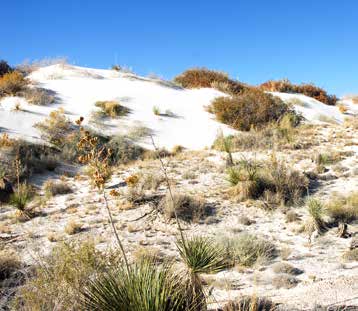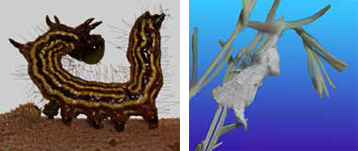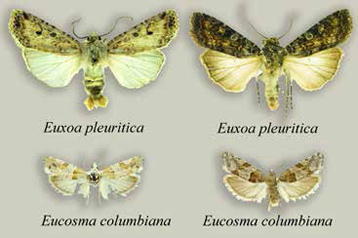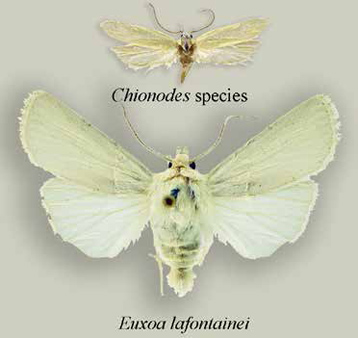Insects comprise the largest number of species, the most numerous individuals, and the greatest biomass of all plants and animals on the planet. They inhabit nearly every niche, and exhibit nearly every lifestyle. They are important herbivores, detritivores, carnivores, scavengers, parasites, vectors of disease, agricultural pests, and pollinators. Because of their biological prominence, consideration for their continued existence at White Sands National Monument (NM) is important.
As the second largest order of insects, and because of their popular appeal, butterflies and moths (Lepidoptera), are well known compared to other insect orders. As herbivores, Lepidoptera respond directly to plant communities, thus they are an ideal group of animals for conducting a quick analysis of habitat quality and health. In the case of White Sands NM, a cursory inventory of moths (94% of all Lepidoptera) disclosed a previously unknown concentration of endemic species in several families of moths.
The Study

© Eric Metzler
Prior to the beginning of the study of moths in 2007, the accumulated knowledge of insects in the white gypsum dunes was minimal.
A transect three km long and approximately 300 m wide was established along Big Pedestal Road west of the monument’s Administration Building. Eleven sample sites were selected in four habitat types: open dunes with no vegetation, interdunal habitat, edge-of-dunes where the dunes abruptly end, and open basin desert habitat. Because vegetation types are markedly different in many of the interdunal habitats, more than one interdunal habitat was selected.
Adult moths were collected monthly in bucket-type black light traps. All moths were sorted to species, identified, and counted. Representatives of each species were mounted on pins, and the wings were spread for permanent storage in research collections. Lepidopteran immatures were collected alive on food plants and reared in laboratory conditions. Representative larvae were preserved in ethanol.
|
Research Objectives The objectives of the assessment of insects, especially butterflies and moths (Lepidoptera), at White Sands National Monument are to inventory Lepidoptera at the monument, and to associate the distribution of lepidopteran species with the several habitats in the monument. Objective 1 - Take regular samples of moths and count butterfly species from selected sites in the monument. |
Individual rear legs were removed from some pinned adults and submitted to the Barcode of Life Data System (BOLD) laboratory at the Biodiversity Institute of Ontario, University of Guelph in Guelph, Ontario, Canada. The resulting “Neighbour Joining Tree” cladograms were used to help delineate species and define new species.

© Eric Metzler
Many specimens were submitted to experts at the U.S. National Museum, the Canadian National Collection, and other individuals for examination and consultation.
The first few samples from the study sites contained several species of moths never before seen by anyone. Reassuringly, but not surprisingly, many of the undescribed species are white or very pale in color.
|
Moth Species Described from the Study Noctuidae Protogygia whitesandsensis Tortricidae Cochylis yinyangana |
In response to the high number of undescribed species, the study now concentrates on documenting and describing the new species. Seven species were described that are new to science, and manuscripts were prepared for the description of several other species.
Primary types were deposited in the Smithsonian Institution. All other moth specimens were deposited in the Museum of Southwestern Biology at the University of New Mexico; Albert J. Cook Arthropod Research Collection, Department of Entomology, Michigan State University; Arthropod Museum, New Mexico State University; and McGuire Center for Lepidoptera and Biodiversity, Florida Museum of Natural History. All non-lepidopteran insects were placed in ethanol and deposited at the University of New Mexico.
Results
|
Moth Species New to Science Noctuidae . . . . . . . . . . . . . . . . . 6 species |
Twenty-four undescribed species of moths in seven families were identified and defined. Most micro-lepidopterans and Geometridae have yet to be examined. The descriptions of seven new species from two families were published in peer reviewed journals.
Several species of moths have adults with whitish or paler phenotypes within the dunes. New research shows the same species of plants in the dunes and outside the dunes have different chemical signatures and different microbes. These results mean that caterpillars in the dunes have a different diet than caterpillars eating the same plant species outside the dunes.

© Eric Metzler
Discussion
The data indicate that the study area is home to more endemic species of Lepidoptera than any other single habitat of similar size in North America. These data are amazing for an area of such small geographic area (712 km2) and young geological age (ca. 8,000 years before present).
Management Implications
Notwithstanding agricultural settings, a modest number of studies using fire in small managed habitats, and experiments to measure impacts of insecticides for population control of exotic pests, such as gypsy moths, the response of lepidopterans to management techniques in natural settings is unknown.

© Eric Metzler
Recommendations
No radical management changes which might negatively impact insects should be undertaken in the monument. The only management techniques to be employed are those regimes that imitate what occurs naturally.
Future research on lepidopterans should attempt to capture gravid females to obtain ova for rearing on plants from within and outside the dunes. Attempts should be made to locate larvae in the field on their natural host plants. Because all lepidopterans come from caterpillars, the opportunities for evolutionary studies in a small geographical area with known geological ages are enormous. The National Park Service owns a unique natural laboratory; the opportunities for research should be exploited.
For More Information
Eric Metzler, metzlere@msu.edu
References
Metzler, Eric H. and Gregory S. Forbes. 2011. Rediscovery and description of Sparkia immacula (Grote, 1883) (Noctuidae, Noctuinae, Hadenini). The Lepidoptera of White Sands National Monument, Otero County, New Mexico, USA 2. http://dx.doi.org/10.3897/zookeys.149.1516
Metzler, Eric H. and Gregory S. Forbes. 2011. A new species of Aleptina Dyar, 1902 (Lepidoptera, Noctuidae, Amphipyrinae, Psaphidini). The Lepidoptera of White Sands National Monument, Otero County, New Mexico, USA 3. http://dx.doi.org/10.3897/zookeys.149.1517
Metzler, Eric H. and Gregory S. Forbes. 2011. A new species of Schinia Hübner, 1818 (Lepidoptera, Noctuidae, Heliothinae). The Lepidoptera of White Sands National Monument, Otero County, New Mexico, USA 4. http://dx.doi.org/10.3897/zookeys.149.1518
Metzler, Eric, David Bustos, and Gregory Forbes. 2009. Two new species of Noctuidae (Lepidoptera, Noctuinae, Agrotini). The Lepidoptera of White Sands National Monument, Otero County, New Mexico, USA 1. http://dx.doi.org/10.3897/zookeys.9.182
Prepared by Chihuahuan Desert Network Inventory and Monitoring Program, 2013.
Last updated: February 1, 2017
